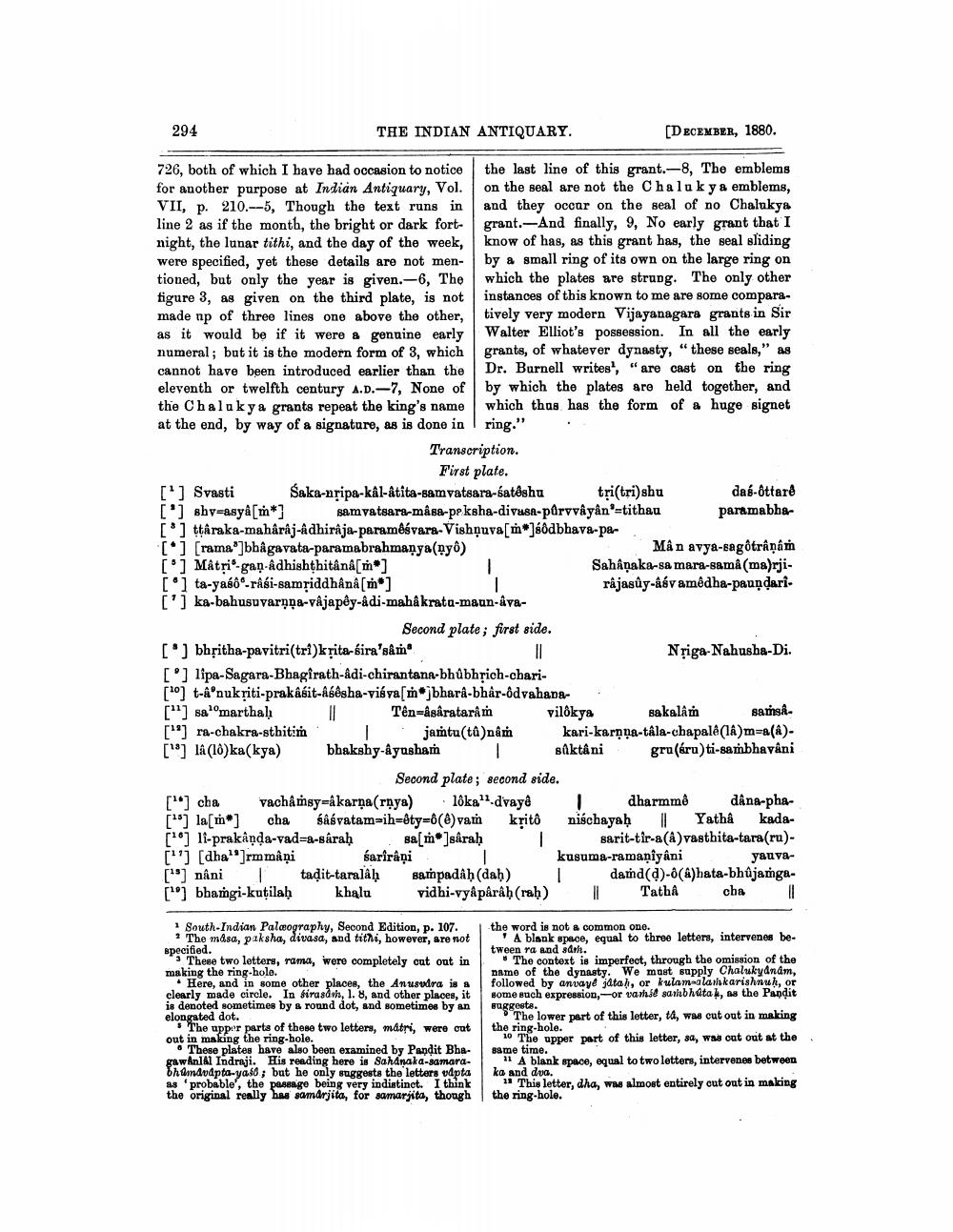________________
294
THE INDIAN ANTIQUARY.
[DECEMBER, 1880.
726, both of which I have had occasion to notice the last line of this grant.--8, The emblems for another purpose at Indian Antiquary, Vol. on the seal are not the Chalu k ya emblems, VII, p. 210.--5, Though the text runs in and they occur on the seal of no Chalukya line 2 as if the month, the bright or dark fort- grant.-And finally, 9, No early grant that I night, the lunar tithi, and the day of the week, know of has, as this grant has, the seal sliding were specified, yet these details are not men- by a small ring of its own on the large ring on tioned, but only the year is given.-6, The which the plates are strung. The only other figure 3, as given on the third plate, is not instances of this known to me are some comparamade np of three lines one above the other, tively very modern Vijayanagara grants in Sir as it would be if it were & genuine early Walter Elliot's possession. In all the early numeral; but it is the modern form of 3, which grants, of whatever dynasty," these seals," as cannot have been introduced earlier than the Dr. Burnell writes", "are cast on the ring eleventh or twelfth century A.D.-7, None of by which the plates are held together, and the Chaluky a grants repeat the king's name which thas has the form of a huge signet at the end, by way of a signature, as is done in ring."
Transcription.
First plate. [ ] Svasti Saka-nripa-kâl-&tita-samvatsara-satôshu tri(tri)shu das-êttare [') shv=asya[m*] samvatsara-masa-peksha-divasa-parvvâyân-tithau paramabha [*] ttâraka-mahârâj-Adhiraja-paramêśvara-Vishộuva[m*]áôdbhava-pa[] [rama"]bhagavata-paramabrahmanya(yo)
Mân avya-eagôtranam ['] Mátri-gan-adhishthitânâ[m*]
Sahâņaka-sa mara-sama (ma)rji[*] ta-yaboo-råsi-samriddhânå [mo]
rajasůy-kévamedha-pauņdari['] ka-bahusuvarņņa-vâjapêy-adi-mahåkrata-maun-dva
Second plate; first side. [] bhritha-pavitri(tri)krita-sira's&m
Nriga-Nahusha-Di. [°] lipa-Sagara-Bhagirath-adi-chirantana-bhubhrich-chari[O] t-&'nukriti-prakâsit-Abêsha-vibya[mojbhara-bhår-odvahapa[] sao°marthal || Tênzagarataram vilôkya Bakalam satsêp\?] ra-chakra-sthitim
jamtu(tânám k ari-karnna-tâla-chapalé (1) m-a(A)[":] lá (10)ka(kya) bhakshyâyasham | Baktâni g ru(áru) ti-sambhaváni
Second plate; second side. ["] cha vachâmsy=&kara(rnya) loka dvayê
dharmmo dana-pha["] la[m] cha sasvatam=ih=ôty=6 (8) vam kritô niścbayaḥ Yatha kada[1] li-prakanda-vad=a-sáraḥ sa[m ]sårah T
s arit-tir-a(a)vasthita-tara(ru)["] [dha""]rm måņi sarirani kusuma-ramaniyâni
yauva1) nâni tadit-taralah sampadâh (dah)
damd(d)-0(A)hata-bhujanga[] bhangi-kutilah khalu vidhi-vyåpârâh(rah)
Tathi cha
· South Indian Palæography, Second Edition, p. 107. the word is not a common one.
* The masa, paksha, divasa, and tithi, however, are not l 'A blank space, equal to three letters, intervenes bespecified.
tween ra and sath. These two letters, rama, were completely cut out in The context is imperfect, through the omission of the making the ring-hole.
name of the dynasty. We must supply Chalukyanam, Here, and in some other places, the Anusura is a followed by anvaye jatah, or kulamaalashkarishnuh, or clearly made circle. In firasat, 1.8, and other places, it some euch expression, or vame sarbata , as the Pandit is denoted sometimes by & round dot, and sometimes by an suggests. elongated dot.
The lower part of this letter, td, was cut out in making $ The upper parts of these two letters, matri, were cut the ring-hole. out in making the ring-hole.
10 The upper part of this letter, sa, was cut out at the • These plates have also been examined by Pandit Bha- same time. gawAnlal Indraji. His reading here is Sahanaka-samara- "A blank space, equal to two letters, intervenes between bhamdvdpta-yaso; but he only suggests the letters vdpta ka and dva. as probable', the passage being very indistinct. I think 11 This letter, dha, was almost entirely cut out in making the original really has samarjita, for samarjita, though the ring-hole.




